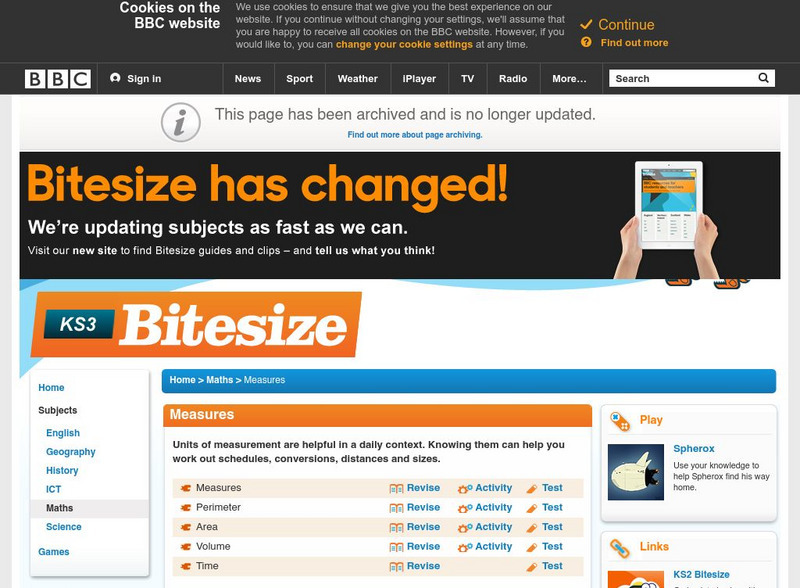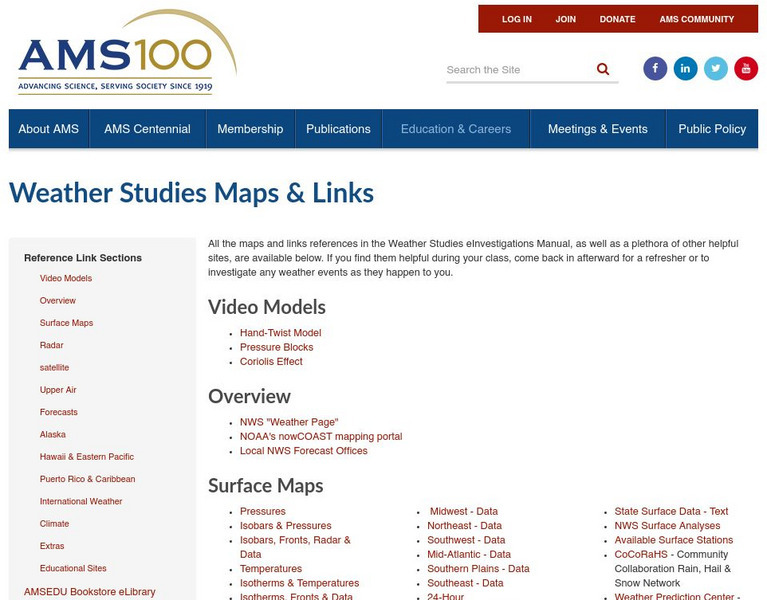Hi, what do you want to do?
Concord Consortium
Concord Consortium: Stem Resources: Melting Ice
Using temperature probes, students will monitor the temperature of melting ice cubes in different situations. This lab activity, allows students to view the procedure and answer questions online that can be saved and evaluated by the...
BBC
Bbc: Revise Wise: Measures
This teaching site has interactive exercises using different types of measurement. You will measure length, capacity, area, perimeter, time, weight, temperature, and speed.
Texas Education Agency
Texas Gateway: Temperature, Kinetic Theory, and the Gas Laws: Temperature
By the end of this section, you will be able to define temperature; convert temperatures between the Celsius, Fahrenheit, and Kelvin scales; define thermal equilibrium; and state the zeroth law of thermodynamics.
Other
Water on the Web
Water on the Web (WOW) is an advanced site allowing students to actively participate in data analysis from real research sites. Lesson plans on a range of topics are provided. There is also a tutorial for using Excel to graph WOW data.
Other
American Meteorological Society: Data Streme Atmosphere
This site provides an extensive amount of weather information. Includes current information, forecasting, and historic weather related events. Weather map symbols and terminology explained.
Other
Massachusetts Department of Education: Sunlight Warms Earth's Surface
This unit contains a series of lessons that allow young scholars to explore the effect of sunlight on Earth's natural surfaces of sand, soil, rock, and water. In addition, students explore how the color and material of a surface affects...
US Department of Energy
Fus Ed Web: Physics of a Fundamental Energy Source
An excellent resource on nuclear fusion! Using incredible graphics and excellent discussion, this site (with its several pages) provides an exhaustive online course on the topic. Click on the link for "a Guided Tour" and begin.
PBS
Pbs: El Nino
You can link to the anatomy of El Nino, chasing El Nino, and El Nino's reach. There is a resource page and a search page.
Utah Education Network
Uen: Trb 4:2 Investigation 5 Severe Weather
Learn about severe weather in Utah.
American Chemical Society
Middle School Chemistry: Heating and Cooling a Liquid
This simulation allows students to make observations about how particle motion changes as the overall temperature of a liquid changes.
Utah Education Network
Uen: Utah's Meteorologists
In this activity students will compare and contrast the seasonal weather patterns.
Utah Education Network
Uen: Here Comes the Sun
In this activity, 3rd graders predict, measure, and record temperatures.
NASA
Nasa: Gas Properties Definitions
Use this site to learn about basic gas properties including motion, viscosity, and compressibility. Includes links to activities for all ages.
Utah Education Network
Uen: Trb 3:5 Investigation 6 Heat From Machines
Learn how heat energy can be produced by mechanical and electrical machines.
Utah Education Network
Uen: Sun or Shade?
Use a thermometer to measure the air temperature in several places around the school.
Utah Education Network
Uen: Mapping It Out
Learn about Utah's environments, temperature, elevation, and rainfall.
Utah Education Network
Uen: Warm Me Up!
Identify misconceptions that many might have about heat sources.
Utah Education Network
Uen: Trb 3:5 Investigation 4 Heat Misconceptions
Gloves do not give heat, but will insulate or hold in any heat that is in your hand.
Utah Education Network
Uen: Calendar & Weather Book
Second graders will record and track weather patterns through the year.
Other
Virginia Department of Education: Weather Patterns and Seasonal Changes
By the end of this instructional activity, young scholars will describe the weather for each season. They will also describe how the weather affects the plants, animals, and people during each season. Activities include taking a weather...
Utah Education Network
Uen: Trb 4:1 Investigation 4 Heat Energy and Water
Learn how to differentiate between heat and temperature.
Utah Education Network
Uen: Trb 3:5 Investigation 1 Is It Hot in the Light?
Learn why things in direct sunlight are warmer than things that are not in as much sunlight.












